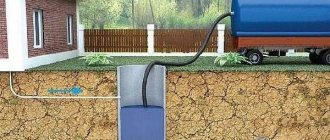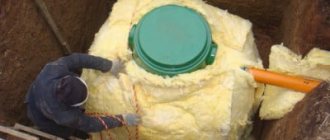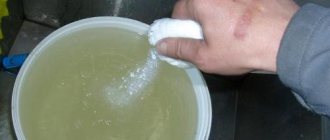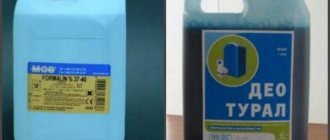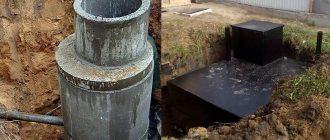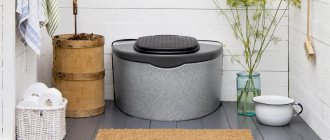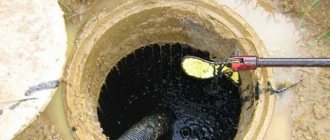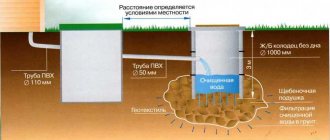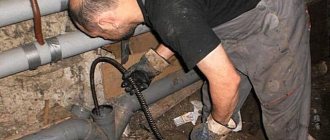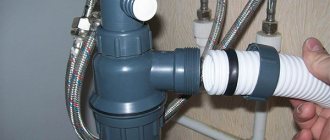- Biological treatment
The question of how to clean a toilet with a cesspool in a country house sooner or later arises before every owner who has a toilet of this type on the site and is concerned about his comfort. On the one hand, there is a whole range of proven methods and means, but on the other hand, the problem arises: which method is preferable from the point of view of greatest efficiency and safety. To make the right choice, you need to learn more about when a cesspool needs to be cleaned, in which cases it is better to use one or another cleaning method, and understand the algorithm of actions.
A country toilet, as a rule, is located far from the house, and access to clean the cesspool using special equipment is difficult
It's time to clean the country toilet
Practice shows that most summer residents try to delay the cleaning process as much as possible, hoping that everything will resolve itself. However, even if a toilet with a cesspool with a volume of 1.5-2 m3 allows you to do without cleaning activities for 7-10 years, the “X” hour will still come. You shouldn’t delay cleaning - it will be much more difficult to remove the amount of sewage that has accumulated over 10 years of using the toilet.
Considering the fact that most often on sites a rustic or classic design of cesspools is used - a simple hole in the ground, without protection of the bottom and walls (at best with a layer of sand and pebbles at the bottom) - overfilling it with sewage threatens with negative consequences:
- contamination of a summer cottage with harmful bacteria and microbes that can harm human health and garden crops;
- attracting flies and other insects;
- accumulation of poisonous and foul-smelling gases in the warm season;
- gradual silting of the pit (especially during wintering of waste);
- complicating the cleaning process.
It is more advisable to clean the toilet in the country before the cesspool is overfilled.
It is recommended to carry out cleaning when the cesspool is filled to no more than 70% of its volume
Pit versus pit: how autonomous wastewater treatment plants work
A cesspool is a rather primitive device for disposing of sewage. But the design itself may have distinctive features that can affect the pumping process. The walls of the wastewater tank can be made of brick, concrete, metal or plastic.
Among other things, waste pits can be completely sealed or those that partially allow the liquid part of the waste to seep into the ground through a bed of sand and small stones.
With such a device, drain cleaning is not required so often PHOTO: kanalizaciya1.ru
Septic tanks contain several compartments, each of which undergoes cleaning of a different nature: using a mechanical or biological method. The result of the operation of such devices can be water suitable for irrigation, but they also need to be periodically cleaned of silt.
Basic methods for cleaning an outdoor toilet
Today, there are two most popular and effective ways to clean the cesspools of private toilets - physical removal of sewage and treatment using special means. Maximum efficiency will be guaranteed when using both methods in combination .
Physical removal of waste
Methods for physically removing sewage from cesspools include:
- manual cleaning;
- mechanical cleaning (using fecal pumps, sewage disposal machine).
Manual cleaning
Despite the great complexity and unpleasantness of such a process, this method continues to be the most common among summer residents. The operating algorithm is as follows:
- Choose the appropriate protective equipment - clothes that you won’t mind throwing away later, rubberized gloves, rubber boots, safety glasses, a respirator (gas mask). If you need to work directly in a pit, you should think about a chemical protection suit or waders and insurance (a belt with a long rope tied to it).
- Prepare the tool. Many people think that a bucket is best. But using a bucket with a rope is not always convenient. If it is suitable for collecting sewage with a liquid consistency, then it will not be able to scoop out viscous slurry, and especially silted masses, and no weighting brick will help here. For such work, it is best to use a scoop on a long stick (you can nail a bucket) and a container for collecting waste. Bayonet and shovel shovels can also be useful. To thicken the consistency and reduce the stench, you can use sawdust or peat.
- Organize a place for disposal of recovered waste. As a rule, a compost pit is dug on the site, in which sewage is mixed with peat, sawdust and soil.
- Scoop out the feces.
It is not recommended to work in a pit alone or even together without insurance. Someone must be at the top and provide backup. Methane is very dangerous and insidious - it has no odor, poisoning with it can lead to sudden loss of consciousness and death if help is not provided in time.
After completing the procedure, traditional methods are used to eliminate the unpleasant odor. For example, tomato tops, sawdust, mint and other aromatic herbs are thrown into the pit.
clean the cesspool manually annually after the end of the summer season , at least at least once every 2-3 years.
Mechanical cleaning
This type of cleaning involves pumping feces from a cesspool using special equipment:
- fecal pumps (it is not practical to use drainage and water pumps for such activities). Their use should theoretically make cleaning safer, simpler and easier. As for facilitating the process, in practice it sometimes turns out the opposite. This is due to siltation of feces, which the pump cannot suck in, so it is necessary to add water to the pit and use a shovel to mix the mass until it has the consistency of slurry. For sewage, you should prepare in advance a closed container with a wide neck for the hose from the pump. In addition, it should be taken into account that the amount of waste with this method will at least double, and you will need to solve the problem of how to get rid of the fetid slurry;
- sewer trucks . This option may well be the ideal solution to the problem - the summer resident simply orders and pays for the service, and the specialists do the rest. Vacuum trucks drive up to the pit in a car, lower a hose into it and pump the contents into a tanker truck, after which they take it away and dispose of it. However, in reality, not everything turns out to be so simple. Firstly, there may be no access to the cesspool (the toilet is located in the depths of the garden). Secondly, the high cost of services. Considering that many country toilets have small pits (less than 1 cubic meter), and payment is taken not for the volume pumped out, but for the number of trips, using the services of vacuum cleaners turns out to be unprofitable.
To facilitate access, in villages, sanitation workers use special composite hoses that allow them to pump out feces from cesspools at a distance of up to 50 m from the road
A significant disadvantage of the first complete pumping of feces in several years is the loss of the ability of the pit walls to absorb liquid and the need to pump out waste annually in the future.
Vacuum truck services
This option is the simplest and fastest. This is due to the fact that a person does not have to do everything on his own. We need to call special people.
The only disadvantage of this method is the high cost. The process of pumping a toilet involves placing all the waste into the machine.
The resident of the house is only required to pay for the work. Professionals will do everything themselves. The cost of the work depends on where the toilet is located, how large the distance from the pit to the road is, and how long it will take for specialists to complete the process. The amount of waste is also taken into account.
Use of special means
Such methods do not provide complete cleaning, but they help to significantly reduce the volume of feces and, thereby, delay the time of mechanical cleaning.
Biological treatment
All over the world, different strains of bacteria capable of decomposing organic matter . The use of such products is completely harmless to both human health and the environment.
Waste generated as a result of bacterial activity can later be used as a safe organic fertilizer
The effect of these drugs is not lightning fast; the bacteria begin to work only after a while. In addition, only their regular use will lead to the desired results. A colony of bacteria can maintain its vital activity from a month to a year.
In order to use bacterial agents correctly, you should know that microorganisms:
- cannot tolerate household chemicals;
- ineffective in conditions of neglected, overcrowded and silted pits;
- die or hibernate at sub-zero temperatures.
Bioremediation products are available in the form of tablets, powders and liquids. Before use, you must carefully read the instructions for their use.
Bacteria in their “dry” form sleep, so they must first be “awakened”. Liquid mixtures are ready for use, but have a shorter shelf life.
Some popular biological products for cleaning cesspools:
| Name (release form, country of origin) | Mode of application | pros |
| Roetech K-47 (liquid, USA) | Shake and pour (one bottle per 2 m3) | Can handle petrified masses |
| "Doctor Robik 109" (powder, USA) | Dissolve in 5 liters of warm water and pour into the hole (1 bag per 1.5 m3) | Affordable price; also breaks down fats, carbohydrates, urea, etc.; suitable for treating sewage in the house; validity period up to 30 days |
| "Green Pine 50" (powder, France) | Pour water until the fecal matter is covered, fill the bag | High concentration of biocultures; environmental friendliness; validity period 7 days |
| BIOFORCE Septic 250 (powder, Thailand) | Dissolve 1 dose in 5 liters of warm water, pour into the hole | Universal septic tank; can be used when the pit is overcrowded; validity period up to 5 months; measuring spoon included |
| BioExpert (tablets, Poland) | Dissolve the tablet in 5 liters of warm water and pour into the hole | Versatility; economical - 1 tablet per 4 m3 |
| "Microzim Septi Treat" (powder, Russia) | Pour 3 buckets of warm water into the hole, pour out the powder (250 g for a volume of up to 2 m3) | Easily tolerates sub-zero temperatures; adapted to Russian soils |
| "Tamir" (liquid, Russia) | Pour into the hole (350 ml per 2 m3). If there is no moisture, add 10 liters of warm water | Versatility; high productivity |
Various biological products of foreign and domestic production
Chemical cleaning
The use of chemical cleaning agents for cesspools and toilets has a range of advantages . Among them:
- ease of use - you just need to pour the reagent into the pit;
- rapid liquefaction of fecal matter;
- high efficiency in combating siltation;
- Possibility of use at any time of the year.
Along with this, there are also a number of disadvantages that call into question the advisability of using chemicals. First of all, we are talking about environmental pollution, the penetration of harmful chemical elements into soil and water. Liquid from the cesspool must be collected in special containers and removed for disposal. Due to their high carcinogenicity and toxicity, some substances (formaldehyde, bleach, etc.) have practically ceased to be used. In this regard, nitrate oxidizers are less harmful, but they are distinguished by higher prices.
When using such products, it is necessary to protect your hands and face from contact with chemicals.
Cleaning not possible: alternative
There are situations when cleaning an earthen toilet pit is either difficult or even impossible (the old structure is dilapidated and threatens to collapse). In this case, a more correct solution would be to dismantle the building, fill the cesspool and move the toilet to a new location. The best materials for backfilling are a mixture of peat, sawdust and earth. The use of sand, construction waste, broken bricks, ash, etc. will make this area unsuitable for gardening work.
If the building is dilapidated, it is worth changing the force of habit and moving the toilet to a new place
If possible, the pit should be pre-treated with a bioactivator, then a layer of a mixture of bulk materials should be laid. Lay bundles of reeds, bush branches or garden tree trimmings on it, then again a layer of bulk materials. This will prevent the danger of falling into an old hole. In a few years, it will be possible to grow cultivated plants in the place of the cesspool.
